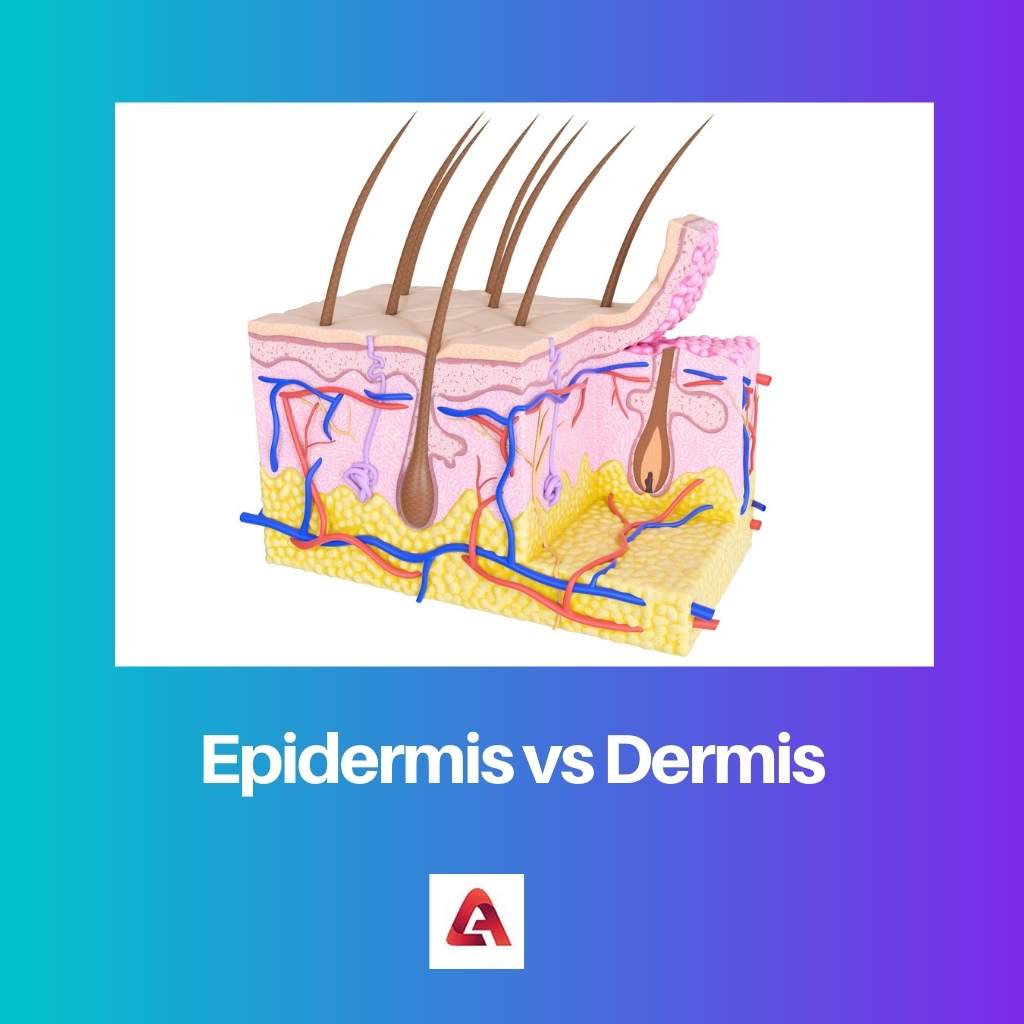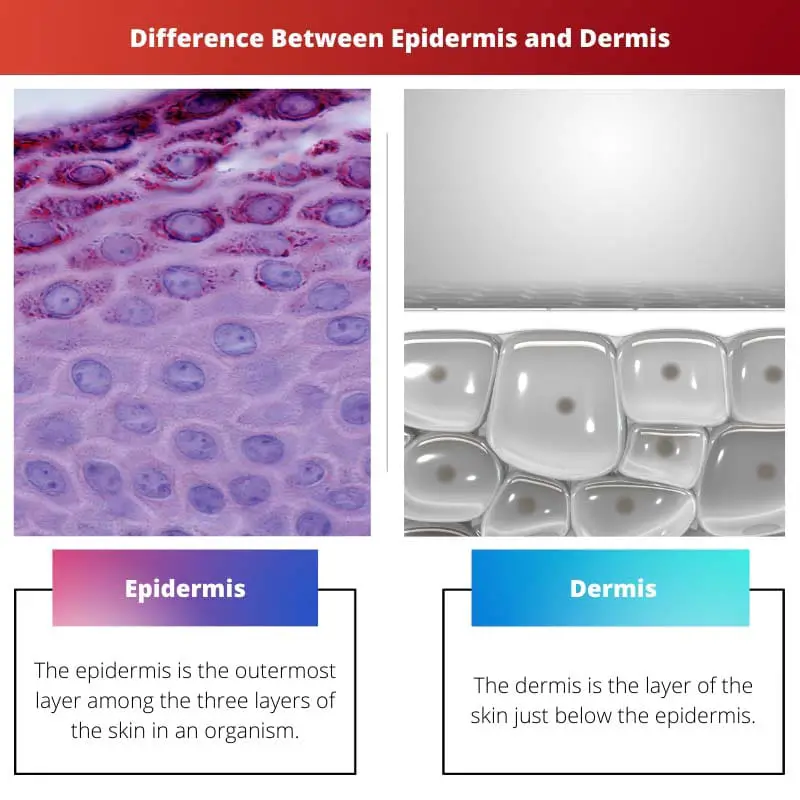Skin is the largest organ in most mammals, especially in human beings. It is the first part of us that encounters a foreign particle. Our skin has different layers, and each layer has its own properties and functions.
Key Takeaways
- Epidermis is the outermost layer of the skin, consisting of dead skin cells, while the dermis is the layer beneath the epidermis, composed of connective tissue and collagen fibers.
- Epidermis serves as a protective barrier, preventing the entry of harmful microorganisms and regulating water loss, while the dermis is responsible for providing structural support and elasticity to the skin.
- Epidermis lacks blood vessels and nerves, while the dermis is rich in blood vessels, nerves, and hair follicles, making it sensitive to touch and temperature changes.
Epidermis vs Dermis
The epidermis is the outermost layer of the skin, serving as a protective barrier against environmental factors and preventing water loss. The dermis is the layer beneath the epidermis, containing tough connective tissue, hair follicles, and sweat glands, providing strength and elasticity to the skin.

The epidermis is the outermost layer of the human skin. It plays the vital role of protecting the delicate inner layers from external foreign particles. The keratinocytes are the cells that form the epidermis.
The dermis is the layer of the skin that is present just under the epidermis. Fat, fibres, collagen, and blood vessels compose this layer of the skin. It has more flexibility and elasticity.
Comparison Table
| Parameters of Comparison | Epidermis | Dermis |
|---|---|---|
| Presence | The epidermis is the outermost layer among the three layers of the skin in an organism. | The dermis is the layer of the skin just below the epidermis. |
| Blood Vessels | Blood vessels are not present in the epidermis. | Blood vessels, a tiny network of blood capillaries, are present in the dermis. |
| Nerves | Nerves are not present in the epidermis. | Nerves are present in the dermis. |
| Found in | Both plants and animals have epidermis. | Only animals have dermis. |
| Absorption of Nutrients | Essential nutrients are absorbed through diffusion from the dermis. | Oxygen and essential nutrients are absorbed through the blood capillaries. |
What is Epidermis?
The epidermis is a unicellular layer, the outermost covering of plants and animals. It acts as a barrier between the environment and the organism. The epidermis is responsible for the prevention and reduction of water loss.
The epidermis is the home of melanocytes, which account for skin tone. This layer has keratin as its base. It is made up of keratinocytes and round-shaped squamous cells, which are called basal cells.
This is a multilayered structure. It is called the basement membrane, as it is responsible for forming a dermo-epidermal junction.
This has led to four more layers within the epidermis: the Stratum basale, Stratum spinosum, Stratum granulosum and Stratum corneum.

What is Dermis?
The dermis, also known as the sodium, is the layer between the epidermis and the tissues called the subcutaneous tissues. The dermis is further classified into two types.
It also consists of elastic fibres, accounting for the skin’s elasticity and firmness. This layer consists of blood vessels responsible for nourishing and removing the gunk from the layers.
This gives strength, extensibility, and elasticity. It is a thicker layer of the skin. The dermis is the depositary of the bone, also known as the earliest evolutionary layer of the skin.
It is also the home of hair follicles. The dermis is further divided into two layers known as the papillary dermis, and the bottom is known as the reticular dermis.
Main Differences Between Epidermis and Dermis
- The epidermis is found in both animals and plants. The dermis is found only in the skin of animals.
- The epidermis comprises keratinocytes, cells containing high amounts o keratin. The dermis consists of sweat glands and hair follicles.

- https://onlinelibrary.wiley.com/doi/abs/10.1046/j.1525-1594.2000.06334.x
- https://physoc.onlinelibrary.wiley.com/doi/abs/10.1113/jphysiol.2001.013067

A commendable scholarly endeavor with intellectual depth and meticulous specificity in detailing the functional aspects of the epidermis and dermis. The article’s scholarly rigor and empirical grounding underscore its significance as a valuable resource for readers.
The article’s meticulous scholarship and insightful exploration of epidermis and dermis contribute to a refined understanding of skin structure and functions. An intellectually stimulating and enriching read.
Absolutely, the article’s comprehensive comparison and detailed analysis illuminate the intricate aspects of skin anatomy, providing a scholarly enrichment for readers interested in dermatology.
The article discusses the fundamental differences and functions of the two main layers of the skin, the Epidermis and the Dermis. Thank you for shedding light on this important topic! I greatly appreciated the in-depth exploration of the epidermis and dermis layers, including their anatomy and functions.
Indeed, an insightful article. It underscores the importance and structure of the skin layers. It serves as a timely reminder of the skin’s vital role as the body’s protective barrier.
The detailed description of epidermis and dermis is truly engaging and educational. This article effectively highlights the significance of these skin layers and their respective functions. A well-researched and informative read.
The informative content provided a deeper understanding of the epidermis and dermis, and their contributions to skin health. The article’s insightful approach offers clarity and enriches the reader’s knowledge.
Absolutely, the article delivers comprehensive knowledge about the epidermis and dermis, and their distinctive roles. It is a valuable resource for readers interested in understanding the complexities of the skin’s structure.
The article provides a compelling exploration of the epidermis and dermis, detailing their distinctive traits and protective functions. A testament to meticulous research and scholarly articulation. A truly enlightening read.
Absolutely, the article’s scholarly approach and detailed analysis enrich the reader’s understanding of the skin’s protective layers. It delivers valuable insights into the complexities of skin anatomy.
The intellectually stimulating content of the article enhances readers’ comprehension of the epidermis and dermis. It exemplifies scholarly rigor and serves as a commendable contribution to dermatology literature.
The comparison between epidermis and dermis is illuminating. This article offers a clear and detailed overview of the key differences and functionalities of both skin layers. An enlightening and intellectually stimulating piece.
Indeed, the article’s emphasis on contrasting the epidermis and dermis helps readers comprehend their unique characteristics and vital roles. It serves as a commendable resource for reference and understanding.
This article is an excellent source of information on skin’s anatomy and the roles played by epidermis and dermis. I appreciate the thorough comparison table, which emphasizes the distinguishing characteristics of the epidermis and dermis layers.
Agreed. The comprehensive examination of epidermis and dermis in this article provides valuable insights into how the skin functions as a protective organ. It’s a commendable piece of work.
Yes, the comparison table added significant value to the article and facilitated a comprehensive understanding of the epidermis and dermis. It is an insightful resource for anyone seeking knowledge on this subject.
The article’s emphasis on the epidermis’ protective role and the dermis’ structural functions is commendable. It delivers intellectual depth and clarity, elucidating the complexities of skin anatomy with precision and thoroughness.
An intellectually enriching and empirically-grounded exposition of the epidermis and dermis. The article’s comprehensive delineation of these skin layers reflects scholarly rigor and serves as an invaluable resource for dermatological knowledge.
Indeed, the article’s scholarly approach and analytical depth significantly contribute to readers’ understanding of skin anatomy. It is a commendable scholarly endeavor with far-reaching implications in dermatology.
A thorough and well-articulated examination of the epidermis and dermis. The article’s in-depth analysis effectively elucidates the functions and distinctions of these skin layers. A highly informative and engaging piece.
The article’s intellectual rigor in elucidating the epidermis’ protective role and the dermis’ structural functions is commendable. The comprehensive breakdown of these skin layers enhances reader knowledge on this intricate topic.
Absolutely, the detailed exploration of epidermis and dermis provides readers with a comprehensive understanding of the skin’s structure and protective mechanisms. A commendable contribution to skin science literature.
An astute and well-presented analysis of the epidermis and dermis. The comprehensive approach to delineating the functions and differences of these skin layers reflects intellectual depth and precision. A commendable scholarly endeavor.